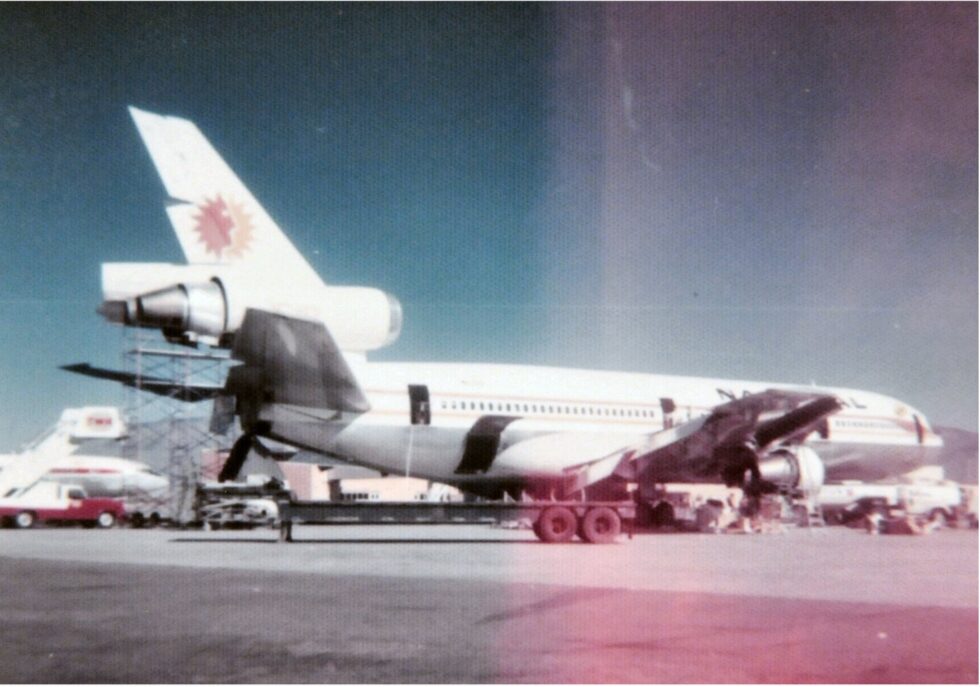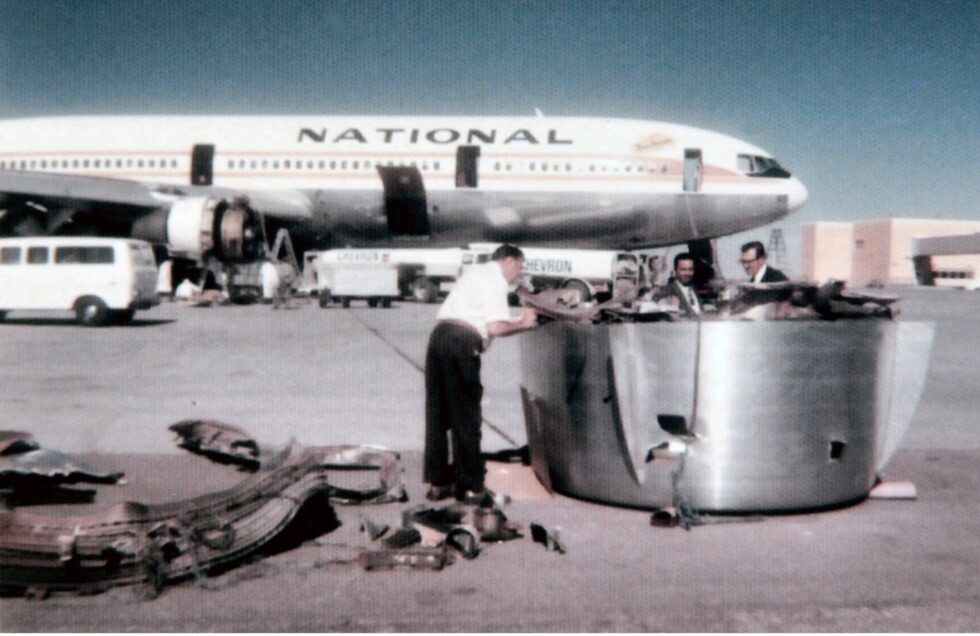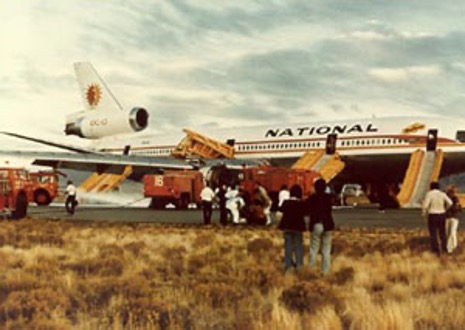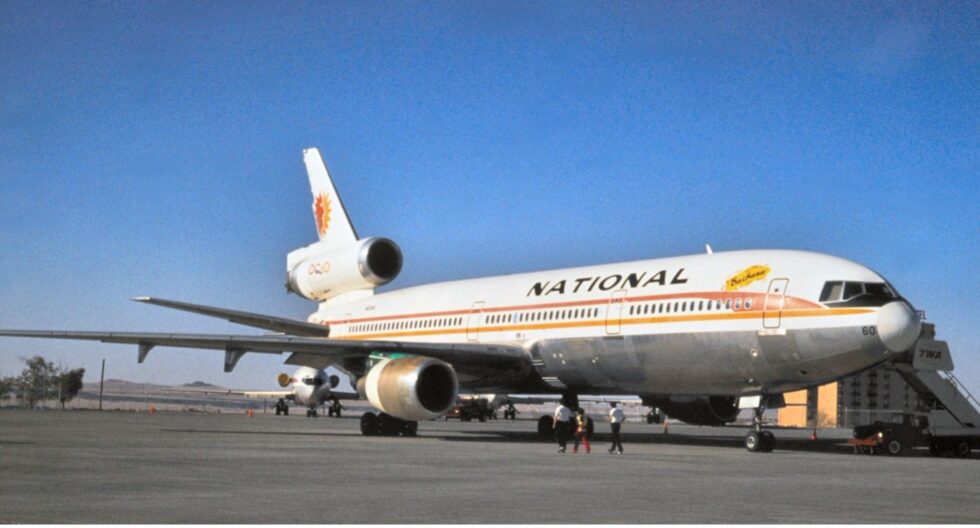National Airlines Douglas DC-10 Barbara

MODEL BY:
H. Davidson
Model Scale:
1/150
MODEL ADDED:
01/13/1977
historical significance
First Albuquerque Visit: 1973
Additional Information:
The McDonnell Douglas DC-10 is an American wide-body aircraft manufactured by McDonnell Douglas. The DC-10 first flew on August 29, 1970 and was introduced to the world on August 5, 1971 by American Airlines. The DC-10, trijet, has two turbofans under the wings and a third turbofan at the base of the vertical stabilizer. The cabin’s twin-aisle layout has a typical seating for 270 passengers in two classes and the DC-10-10 had a 4,000 mile range for transcontinental flights. Early on in the DC-10’s operational life there were safety failures partially attributable to a design flaw in the original cargo doors that caused multiple incidents which included fatal accidents. McDonnell Douglas announced that production would end due to a lack of orders. As the design flaws were rectified and fleet hours were increased, the DC-10 eventually achieved a long-term safety record comparable to those of similar-era passenger jets. Production of the DC-10 ended in 1989 with a total of 386 aircraft delivered to airlines along with 60 KC-10 tankers for the military.
National Airlines was a major airline in the United States that operated from 1934 to 1980 before it merged with Pan American Airlines. Headquartered at the Miami International Airport, Florida for most of its existence, the company at its peak had a network of “Coast-to-Coast-to-Coast” flights, linking Florida and Gulf Coast destinations with cities along the East Coast as well as with large cities on the West Coast including Los Angeles, San Francisco and Seattle. From 1970 to 1978, National, along with several other airlines was the only U.S. airline permitted to operate scheduled passenger flights to Europe. National Airlines was founded by George T. Baker (1899–1963) in 1934. Its headquarters were in St. Petersburg, Florida and it was based at the city’s Albert Whitted Airport until it moved to Miami.
National Airlines placed an order for ten DC-10 aircraft 1969 and the wide body aircraft was put into service on the Miami-New York route on December 15, 1971. In the late 1970s, several airlines attempted to take over National Airlines, which had become a major player in the southern transcontinental and Florida-East Coast airline markets
In 1978, Texas International Airlines acquired 24.6 percent of the company’s shares, but did not succeed in the takeover attempt. A similar play was made by Eastern Air Lines in 1979 and at the same time the shares held by Texas International were sold to Pan American World Airways, who finally succeeded in accumulating a controlling majority of the airlines. On January 7, 1980, the acquisition of National was completed with Pan Am taking over the National Airlines fleet and route network.
On November 3, 1973, a National Airlines McDonnell Douglas DC-10-10, N60NA, named “Barbara”, suffered an uncontained engine failure over Datil, New Mexico while operating as Flight 27 from Houston to Las Vegas. Pieces of the turbine penetrated the fuselage, breaking a window in the passenger cabin and causing subsequent decompression. One passenger was sucked out of the aircraft and killed. The flight made a successful emergency landing at the Albuquerque International Sunport a short time after the accident. In addition to the fatality, 24 passengers sustained minor injuries. This was the first fatal accident involving a DC-10.
Flight 27 took off from Houston, Texas, bound for Las Vegas International Airport. The aircraft leveled off at 39,000 feet and had an indicated airspeed of about 350 mph. At about 16:40 MST, while the aircraft was at cruising altitude 65 miles southwest of Albuquerque, New Mexico, the No. 3 (starboard) engine fan assembly disintegrated in an uncontained catastrophic failure. Smoke was reported to fill the cabin before the fragments of the fan assembly penetrated the fuselage, the numbers 1 and 2 engine nacelles, and the right wing at high speeds, causing a cabin window to dislodge and eject the adjacent passenger from the aircraft. The resultant damage caused decompression of the aircraft cabin and the loss of certain electrical and hydraulic systems. Multiple compressor blades punctured the fuselage and also damaged the port engine. One blade burst a window, and a passenger seated next to window was ejected by decompression of the fuselage. His body went over top of the fuselage and was sucked into the #3 engine mounted in the aircraft’s vertical stabilizer disabling that engine.
The flight crew initiated an emergency descent, and the aircraft landed safely at Albuquerque International Sunport 19 minutes after the engine failed. The aircraft made an emergency landing on runway 26. As the aircraft exited onto the taxiway, the port engine shut down due to oil starvation from a blade strike. All 115 passengers and 12 crew members exited the aircraft by using the evacuation slides.
Of the 116 passengers on board, 24 people were treated by medical personnel from nearby Kirtland Air Force Base for smoke inhalation, ear problems, and minor abrasions. One passenger was partially blown into the opening made by the failed cabin window, after it too was struck by engine fragments. He was temporarily retained in that position by his seatbelt. “According to a witness, the occupant of the seat was partially forced through the window opening and was temporarily retained in this position by his seatbelt. Efforts to pull the passenger back into the airplane by another passenger were unsuccessful, and the occupant of seat 17H was subsequently forced entirely through the cabin window.”
The New Mexico State Police and local organizations searched extensively for the missing passenger, George F. Gardner of Beaumont, Texas, who was sucked out of the window. Computer analysis was made of the possible falling trajectories, which narrowed the search pattern however, the search effort was unsuccessful. A ranch hand later found a pair of sunglasses and a tobacco pipe while working on a ranch near Alamo, New Mexico. He turned over the items to the New Mexico State Police and the family of the missing passenger identified them as belonging to Gardner.
According to one source, “Two years after the incident, construction began on the Very Large Array radio telescope. While building the tracks north of U.S. 60, the VLA track crew made a gruesome discovery by uncovering human remains. The New Mexico Office of Medical Investigator was contacted and removed the remains to Albuquerque for identification and cause of death. After nearly a year, it was determined the skeletal remains found on the VLA north arm was that of passenger 17H of Flight 27. The cause of death was fairly obvious and the remains were returned to the family in Texas.
All 3 engines were replaced and the fuselage was patched at Albuquerque. The aircraft later returned to service. After the plane was repaired returned to service it was later flown by Pan Am.
GALLERY:
SEARCH OUR DATABASE:




